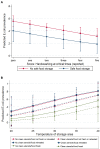Key Food Hygiene Behaviors to Reduce Microbial Contamination of Complementary Foods in Rural Bangladesh
- PMID: 35895343
- PMCID: PMC9490651
- DOI: 10.4269/ajtmh.21-0269
Key Food Hygiene Behaviors to Reduce Microbial Contamination of Complementary Foods in Rural Bangladesh
Abstract
Microbial contamination of complementary foods puts young children at risk of developing intestinal infections and could be reduced by improved handwashing and food hygiene practices. We aimed to identify which promoted food hygiene practices are associated with reduced complementary food contamination in a rural population in Bangladesh. We collected cross-sectional data on reported and observed maternal food hygiene behaviors and measured Escherichia coli counts as an indicator of microbial contamination in complementary food samples from 342 children of women enrolled in the Food and Agricultural Approaches to Reducing Malnutrition trial in Sylhet, Bangladesh. We used multivariable logistic regression to examine associations of food hygiene behaviors with food contamination. Approximately 46% of complementary food samples had detectable levels of E. coli. Handwashing with soap at critical times and fresh preparation of food before feeding were strongly associated with reduced odds of food sample contamination (odds ratio [OR]: 0.8, 95% confidence interval [CI]: 0.6-0.9 and OR: 0.3, 95% CI: 0.1-0.7, respectively); in contrast, there was no or only weak evidence that reheating of stored food, safe food storage, and cleanliness of feeding utensils reduced contamination. Reduction in food contamination could be more than halved only when several food hygiene behaviors were practiced in combination. In conclusion, single food hygiene practices showed limited potential and a combined practice of multiple food hygiene behaviors may be needed to achieve a substantial reduction of complementary food contamination.
Figures




Similar articles
-
Effect of a behaviour change intervention on household food hygiene practices in rural Bangladesh: A cluster-randomised controlled trial.Int J Hyg Environ Health. 2024 Jan;255:114291. doi: 10.1016/j.ijheh.2023.114291. Epub 2023 Nov 18. Int J Hyg Environ Health. 2024. PMID: 37983985 Clinical Trial.
-
Design, delivery, and determinants of uptake: findings from a food hygiene behavior change intervention in rural Bangladesh.BMC Public Health. 2022 May 4;22(1):887. doi: 10.1186/s12889-022-13124-w. BMC Public Health. 2022. PMID: 35508997 Free PMC article.
-
Escherichia coli contamination of child complementary foods and association with domestic hygiene in rural Bangladesh.Trop Med Int Health. 2017 May;22(5):547-557. doi: 10.1111/tmi.12849. Epub 2017 Feb 24. Trop Med Int Health. 2017. PMID: 28164415
-
Nutrition: basis for healthy children and mothers in Bangladesh.J Health Popul Nutr. 2008 Sep;26(3):325-39. doi: 10.3329/jhpn.v26i3.1899. J Health Popul Nutr. 2008. PMID: 18831228 Free PMC article. Review.
-
Contaminated weaning food: a major risk factor for diarrhoea and associated malnutrition.Bull World Health Organ. 1993;71(1):79-92. Bull World Health Organ. 1993. PMID: 8440042 Free PMC article. Review.
Cited by
-
Prevalence and antimicrobial resistance patterns of nontyphoidal Salmonella in Ghana: a systematic review and meta-analysis.Trop Med Health. 2025 Jul 1;53(1):91. doi: 10.1186/s41182-025-00731-7. Trop Med Health. 2025. PMID: 40597407 Free PMC article. Review.
-
Bacteriological quality and safety of bottle food and associated factors among bottle-fed babies attending pediatric outpatient clinics of Government Health Institutions in Arba Minch, southern Ethiopia.J Health Popul Nutr. 2023 May 26;42(1):46. doi: 10.1186/s41043-023-00387-1. J Health Popul Nutr. 2023. PMID: 37231498 Free PMC article.
-
Campylobacter colonization and undernutrition in infants in rural eastern Ethiopia - a longitudinal community-based birth cohort study.Front Public Health. 2025 Jan 7;12:1467462. doi: 10.3389/fpubh.2024.1467462. eCollection 2024. Front Public Health. 2025. PMID: 39839388 Free PMC article.
-
Risk factors for food contamination among children discharged from community management of acute malnutrition programmes in South Sudan: A cross-sectional study and hazard analysis critical control point approach.Matern Child Nutr. 2024 Apr;20(2):e13612. doi: 10.1111/mcn.13612. Epub 2023 Dec 25. Matern Child Nutr. 2024. PMID: 38143422 Free PMC article.
-
Effect of a Homestead Food Production and Food Hygiene Intervention on Biomarkers of Environmental Enteric Dysfunction in Children Younger Than 24 Months in Rural Bangladesh: A Cluster-Randomized Controlled Trial.Am J Trop Med Hyg. 2023 Oct 2;109(5):1166-1176. doi: 10.4269/ajtmh.23-0153. Print 2023 Nov 1. Am J Trop Med Hyg. 2023. PMID: 37783459 Free PMC article. Clinical Trial.
References
-
- WHO , 2015. WHO Estimates of the Global Burden of Foodborne Diseases. Foodborne diseases burden epidemiology reference group 2007–2015. Geneva, Switzerland: World Health Organization.
-
- Owino V Ahmed T Freemark M Kelly P Loy A Manary M Loechl C , 2016. Environmental enteric dysfunction and growth failure/stunting in global child health. Pediatrics 138: e20160641. - PubMed
LinkOut - more resources
Full Text Sources

